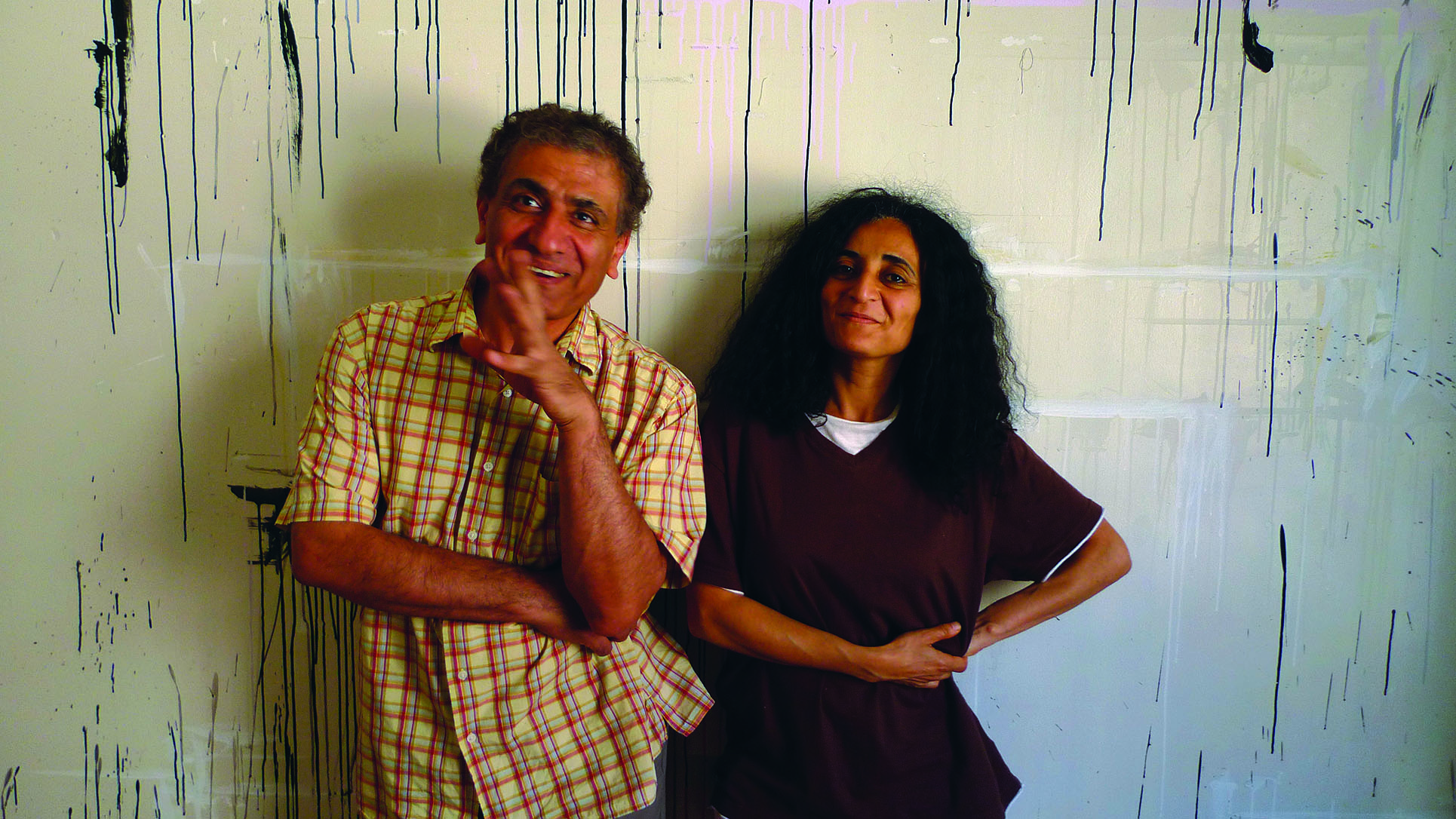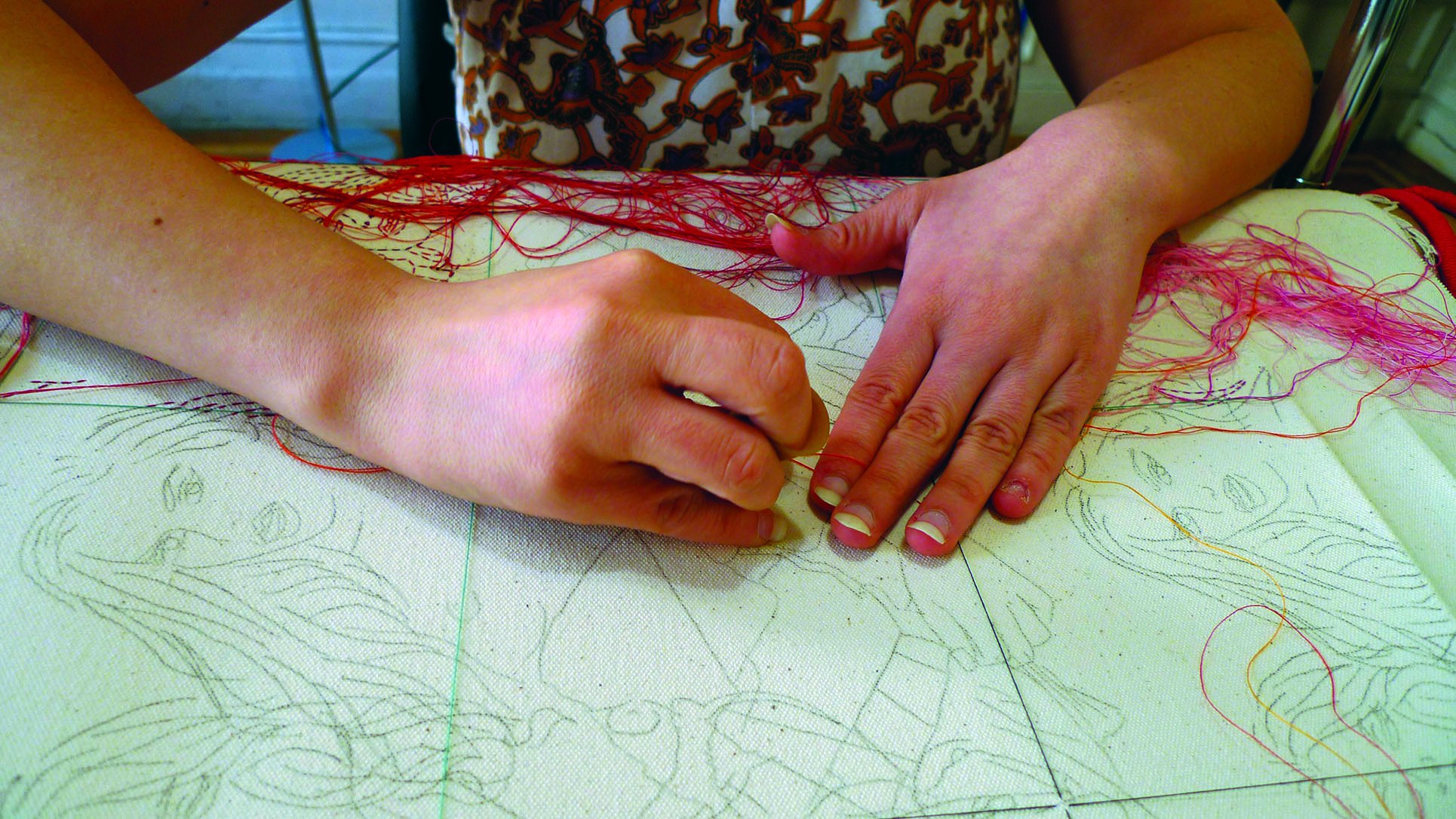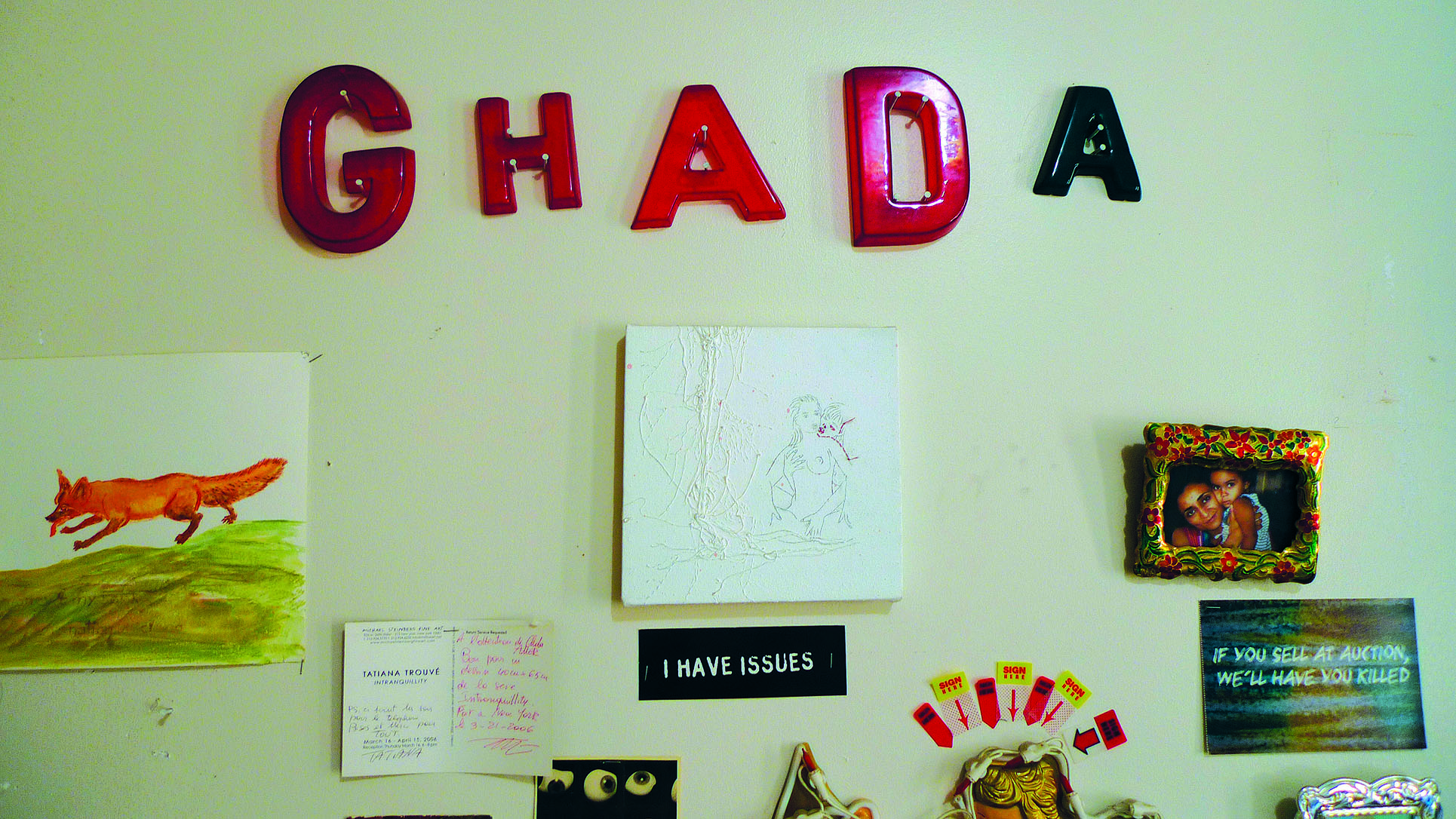Embroidered Misbehaviour
For some twenty years the Egyptian born artist Ghada Amer, now based in New York, has been questioning relationships of power, expressed through archetypes of gender and sexual representations, with her production of drawings, paintings, sculptures and garden installations. Amer’s artistic research about sexual identity and following social rules doesn’t stop at contents (as definitions of specific words or porn imagery) and its meanings, but passes on to a further formal reflection which questions the (political) meaning of media itself, and continuously invents new technical combinations. During her art education in France, Amer perceived the field of painting, which strongly interested her, as a sort of forbidden territory, occupied mainly by men. She felt in a way excluded and started to react by seeking a female language capable of its own strength of expression, in order to build up a kind of opposite planet to male power. At the beginning of the 1990s, she started using embroidery as a typically feminine tool, but without renouncing the aesthetics of painting, often quoting (ironically) from the more recent history of art: Abstract Expressionism, Pop Art, and also Matisse, Picasso etc.
The first embroidered series of women doing housework didn’t satisfy Ghada Amer, because she felt that her subjects were being too much subjugated into their traditional role. So in 1992 she started her embroidered porn series, which brought her enormous success. Pornography here is meant as a rebellion against moral law not only in Muslim but also Western culture. By ambiguous representation, where you see and don’t see at the same time, Amer aims to create a universal female space where women are empowered and reach consciousness of the self through their own pleasure. Thus most of the porn images show women masturbating or kissing each other. The Western white women, as being the dominant group, are meant to speak about all of womankind in general and should deconstruct phallocentric concepts of passive and silent women by discovering and imposing their own language and pleasure. On the other hand, Amer is conscious of the inherent danger of using images produced by men for men: she is aware that she could get her hands dirty by using these means…
Along with the constant production of embroidered paintings, for years Ghada Amer has continued her research with text pieces, sculptures and garden installations. She made a series of paintings with definitions of words such as ‘Freedom’, ‘Peace’, ‘Security’, ‘Fear’. In the garden installations, too, she often uses words or symbols, creating a paradoxical meaning as, for example, in Love Grave (2003), where she carved into the ground the word ‘Love’, creating a grave for (dead) love, or in Peace-Garden (2002), where the peace symbol has been planted out with carnivorous plants, the only existing aggressive, war-making plants. In recent years Ghada Amer has increased her collaboration with Reza Farkhondeh, an Iranian-born artist based in New York: they won several artist residencies together, and their common production of works on paper has met with great interest.
Barbara Fässler: Ghada Amer, you’ve had shows all over the world in the most prestigious art institutions and galleries, you have exhibited twice at the Venice Biennale, at Macro in Rome and at Brooklyn Art Museum, you have worked with the Deitch Project, Gagosian Gallery and currently you collaborate with Cheim & Read, New York. In the recent period, you have featured in major art auctions: how do you explain your huge success and its duration?
Ghada Amer (laughing): It’s luck, I think, and I have taken advantage of a situation where suddenly artists from the periphery have started to show their work and are being recognised in the West. At the beginning I exhibited in institutions that weren’t very visible, with unknown curators who became very successful only later. But when I started, it was really outside the big institutions, far away. Only after the exhibition Les Magiciens de la Terre, in 1989 at the Centre Pompidou Paris, curated by Jean Hubert Martin, people realized that there is another art world over there.
BF: A sort of “Exotic-Bonus”?
G.A.: Exactly. So that’s how I arrived to the market and on the scene. It was basically luck.
BF: But the success went on and kept going. Did you work a lot?
G.A.: Yes, I worked very hard and I moved from France. New York is the art centre of the world and if you want to become an artist, you have to come here. But I also have been quite lucky, actually, to meet the right people at the right moment: it happened more in a simple way than in a strategic way
BF: Do you think that, beside the “Exotic-Bonus”, there exists a “Female-Bonus” as a reaction to the male dominated (art) world?
G.A.: No, there is a “Female-Malus”.
BF: Still, now? Aren’t problems of inequality considered to have been overcome? Don’t you think that this situation is better nowadays?
G.A.: No, I think it is better to be Egyptian than to be a woman. As a woman it’s very difficult to achieve high prices at a major auction. Even very famous Western women like Louise Bourgeois have had the same difficulties. No, that hasn’t changed at all.
BF: At auctions, how many women get there?
G.A.: I don’t know precisely, but recently I read an interesting article that I should send to you about the Art Fair in Basel: the top 40 of the most represented artists are all exclusively men.
BF: Oh dear, that’s incredible.
G.A.: ..only after 40 male artists do we have the first woman.
BF: What sort of art works can survive and function in the market today?
G.A.: I don’t know. I don’t care, I hate the market and I hate option analysis.
BF: Have you felt any consequences of the present economic crisis in your work?
G.A.: Yes, of course, like everybody. Last year there was a big crash in the business. Then I changed my gallery. Now things are much better for me.
BF: Do you think that there exists a market “dictate” for what concerns the contents of an art production, once an artist represents a value in the market?
G.A.: I’m very well known for my embroidered paintings, but I do many more other things than that, like garden projects, drawings, videos, performances, however people only know and demand this limited aspect of my work. The other stuff is very difficult to sell, and even to show. People want a brand.
BF: Even the curators from institutions, who are not dependent on selling?
G.A.: No, the curators less so.
BF: They are more open-minded, I hope.
G.A.: Yes, they are, definitely. But you were talking about the market.
BF: Yes, because I think that even not-for-profit institutions are still connected to the market.
G.A.: No, they aren’t. For example Rosa Martinez, an independent curator, responsible for one of the Venice Biennales, didn’t want the paintings, but invited me ten times to develop my garden. It’s only because of those open-minded curators that I can go on doing these projects, otherwise I wouldn’t have the possibility of doing them.
BF: I wanted to say that independent and institutional spaces are related to the market in the sense that the market is going to make use of those institutions which are able to and allowed to run more risks. Those spaces may first show artists who are less known and galleries will then pick them up, because they think that the spaces give the works a guarantee of quality.
G.A.: Okay, I agree with you.
BF: Now we could talk about your work, which has a very provocative note. Coming from Muslim culture, where representation of any part of the human body is not allowed, you confront the public with strongly male Western pornographic visual culture. In the embroidery-paintings the contents are still hidden – see and not see, but in the latest watercolour drawings the message is brutally direct. Is the provocation a strategy for publicity, or should we read the masturbation pieces as a metaphor for the figure of the artist and the pornographic paintings as a representation of our society which makes money out of the “real” feelings like love, or authenticity in general?
G.A.: My work is never intended to be provocative. I don’t have a strategy of being provocative and I don’t want to be provocative. I’m working on pornography because of personal issues, because of my cultural conditioning that declares sexuality as something bad or immoral. I am doing this for myself. Representation of the body, and of course of sexuality, is not only forbidden in Muslim society, but also in Jewish and Christian cultures and religions. So I am not doing anything different than if I had grown up in a Jewish or Protestant context. By the way, I don’t believe that pornography is selling love or feelings: it’s selling pleasure. There is no feeling in pornography.
BF: Why did you choose to talk about the condition of women in your artwork?
G.A.: Because I’m a woman, it touches me. In my art I’m talking about myself. It’s a sort of a self-portrait.
BF: From your experience, how does the public receive your message?
G.A.: I don’t want to send any message to the public. My work is meant to be a poetic expression of myself, without any intention towards the public.
BF: For years you have been collaborating with Reza Farkhondeh: do you think that artists should get over their solipsistic, egocentric way of working and look for more interaction?
G.A.: The collaboration with Reza is very important for both of us. It helps us to get beyond our limits and to question our way of working and thinking. The exchange saves us from eternal repetition of the same structures, and helps us to survive crises and accept change in our work. So when we produce series of paintings or drawings together, every single piece is very different from the other. We find the strength to avoid repetitive mechanisms by questioning each other in a continuous creative process. In the last series of drawings we produced together*, we eliminated for the first time any embroidered works and I must say that I was very much afraid of taking this path, but Reza pushed to dare with new experimentation. Now, I really feel it like a liberation from huge pressure. The market always requests the same kind of works which get a sort of label which imprisons the artist. Formally our collaboration was not always easy to handle, because it was difficult for many people to accept canvases with two signatures. So in 2001 I invented a secret sign for the common works: RFGA, in order to mark them. With my new gallery, we have resolved the problem very easily. We behave as if there were three artists: Ghada, Reza and Ghada & Reza.
BF: Ghada, we have known each other for twenty-six years. I still remember very well when we first met in the queue of the res- taurant at the Villa Arson Art School in Nice. We have led very different lives, since then and also before then, but I think it’s great that we are now doing this interview together, eighteen years after I organized in Zurich, at our artist space ProjektRaum, one of your first single shows. If you had in front of you some 21 year old kids, as we were when we first met and started out on our artistic formation, what advice would you give them for their future?
G.A.: It’s very difficult to give any advice. For sure, though, I think that it is important to practice art, to keep pursuing sincere and authentic research, and definitely not to focus only on making a career or earning much money…
BF: Thanks a lot.
Barbara Fässler
* The show by Ghada Amer & Reza Farkhondeh, The Gardens Next Door, at Galeria Filomena Soares, Lisbon, open till 6 November 2010


